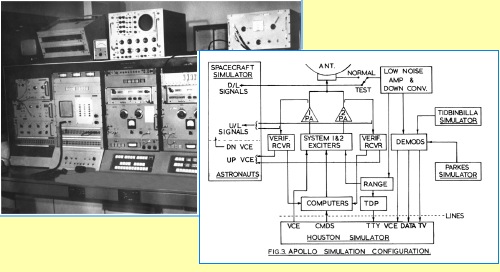Regarding the small ‘Near Coll Tower’, Neil Sandford writes:
“The RF of the Sim System was originally only available via the Test Inject network which had to be disconnected during missions. So the Near Coll Tower was installed enabling Sim Signals without hard connection. It also provided a more realistic test via the Main or Acq Antenna plus a quick Antenna tracking check.
The 3 X 20 ft section Hills wind up tower was installed to provide Sim System RF signals via a Col Cochran homemade S-band antenna, connected via coax cable.
An interesting experience fortunately with a lucky outcome: We had to lower the mast for some reason and I was at the top of the bottom 20ft section with hard hat, safety boots and safety belt to release each section as they were lowered. My feet were on the diagonal lattice work (difficult at the best of times) of the outer lower section. Can’t recall who was assisting but was a junior who had to release the ratchet pall to operate the hand winch to lower the upper sections. Unfortunately he lost control so the top sections came hurtling down. The unbalanced winch handle caused the tower to vibrate alarmingly making it very difficult to maintain my footing. If my toes had slipped through the outer section, I may have been a few toes short. I also had to concentrate on hanging on but keeping fingers clear.
Having survived that lot the next danger was the Antenna, was mounted on 1/8" thick aluminium plate about 1 ft square, which was directly above me. Luckily it was well attached and stopped short of me otherwise there might have been a nasty meeting with my hard hat. The rough ride seemed to last a long time but in fact was only a few seconds.”
Large, Larger (800kb). Full photo here.
|



